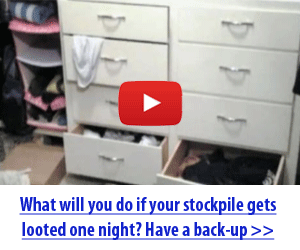One of the most essential supplies you need to stockpile for an emergency or the apocalypse is also one of the hardest to store.
We use water more than any other consumable, which makes it hard to estimate precisely how much you need to guarantee your survival and remain self-sufficient. Remember, you don’t just use it for drinking. You use water for cooking, brushing your teeth, flushing toilets, and keeping yourself clean.
Although it’s unlikely you’re going to be using your stockpiled water in all of these situations as you don’t need your clothes to look their whitest during an emergency event. But how do you know much water you should be stockpiling and what’s the best method to store it so that it’s useable when the time comes to use it?
If you’re in the process of taking stock of your water supply, here’s how you can make sure you’re storing it correctly and that you’ve got enough to survive any event that comes your way.
How Much Water Should You Stockpile?
There’s no question that you should be stockpiling water. What you need to ask yourself is how much you’re going to need. This can depend on several factors. The best place to start is assuming that you need one gallon of water, per person, per day.
This amount of water will be enough to keep you hydrated and hygienic. You might not consume the entire gallon every day. However, you might use some for freeze-dried food, washing your body, and cleaning cooking utensils.
There are other days where you might end up needing more than a gallon. If you need to complete a physically demanding activity or the weather is sweltering, then you’re going to need to replenish your fluids.
So if we’re assuming you need a gallon of water a day per person, how much should you be stockpiling. This equation should give you an indication of exactly how much you need.
- Work out the number of people you’re prepping for – make sure to include your household, extended family members, and any friends you plan to cater for.
- Next, work out how many days you’re stockpiling for.
- Multiply the number of people by the number of days to give you an indication of how many gallons of water you’re going to need.
Where Should Your Water Come From?
You probably think it’s easy to get your hands on some water. After all, it falls out of the sky all of the time. Supermarkets sell bottled water as well. Surely you can grab enough for the household on your next visit.
But this isn’t exactly the most cost-effective way to stockpile water. You’ll likely spend a dollar a gallon, and if you’re getting enough for say, 12 people over a month, it’s going to cost you almost $400.
Storing individual bottles isn’t great either. The plastic packaging isn’t designed to last long periods of time. So there is a chance that eventually, you’re going to have to replace it and throw $400 worth of water down the drain.
You can purchase pre-packaged purified water in storage containers. This is perhaps the best quality water that money can buy. It’s generally cleaner than what comes out of your taps at home.
But the most cost-effective solution is to purchase a purifier yourself, such as the APEC ROES-50 Reverse Osmosis System or the PUR Faucet Water Filtration System. It’s going to cost you a lot less money to purify the water yourself in the long-term. You can even pour it directly into a tank, so it’s ready to go when you need it. Sure, it’s a lot of extra work, but once you get started, you’ll realize that the additional effort is worth it. Especially when you take a look at your bank account.
Do You Need to Purify Your Water?
Purifying your water isn’t always essential before storing it. You can keep the water that comes directly out of your tap. After all, you already drink it today. So why wouldn’t it be safe to store in tanks with the rest of your stockpile?
The only consideration is that there is a higher chance of algae growing in the water. Particularly if you store it in a place where it has access to sunlight. To get around this situation from occurring, you can keep your water clean by adding some drops of bleach.
You need to be extra careful if you plan on doing this. Every six months, you’ll want to add eight drops of bleach to every gallon of water that you’re storing. This is enough to kill any algae or bacteria that may have got into the water.
When the time comes to use the water, you need to make sure that you purify it so that it’s safe to consume and use for all of your needs. Failing to do so could cause you and your household some internal harm if you’re drinking contaminated water.
What Containers Should You Use to Stockpile Water?
There’s no shortage of container options for stockpiling your water. However, if you’re buying used barrels, just make sure that you do your research as to what they were originally used for. Some places sell containers that stored chemicals. So there’s a chance there could be residue remnants that can contaminate your water.
55-gallon tanks are the most popular option. They’re easy to find and simple to store. They fit through doorways, and you won’t have any trouble putting them in the basement. If you can, get your hands on the white barrels instead of the blue ones. White containers like the BayTec brand barrels mean that they’re graded for food and were used to store edible materials.
You should also get your hands on some 50-gallon rain barrels from the RTS Home Accents range. These are built to handle the elements and are perfect for leaving outside on a rainy day. Just make sure to purify the water before consuming it or using it on any of your materials.
Where Should You Stockpile Your Water?
Depending on what type of containers you’re using will depend on where you should store your water to ensure that it lasts the longest amount of time possible.
- If you’re stockpiling your water in plastic containers, then make sure to keep it away from any sunlight and rotate it every six months.
- For rain drums, you can store this outside or underground. Just make sure they have a seal on the lid.
- If you’re storing smaller bottled water, you will want to keep these on shelves in a cool, dark place. Don’t stack them on top of one another, as they’re not always sturdy. They also can puncture easily.
- Canned water is excellent in small amounts. Store this in a pantry out of the sunlight, much like any other canned goods.
What Should You Do if You Run Out of Water?
No matter how much your prep or stockpile, you need to have a plan ready in the event that you run out of water during an emergency situation. The goal should not involve how you’re going to stockpile more. Instead, you need to have an idea of how you’re going to procure enough water for everyone.
In a disaster scenario, you’re more likely to get confronted with viruses and water-borne bacteria. This can lead to diarrhea and stomach bugs that can leave you out of action for days. It also means an overuse of your toilet paper stockpile.
Boiling water should always be your first strategy to cleaning water you’ve procured. It is guaranteed to kill all bacteria and viruses hiding out in the water. The only potential hazard is that you’re literally playing with fire. You need to ensure you have a safe space to boil the water. The other downside is you have to wait for it to cool down before consuming it.
Another option is getting your hands on bleach, iodine, or water purification tablets. These methods are also guaranteed to work but come with the risk of dealing with chemicals. You need to be precise with your measurements. Otherwise, you run the risk of poisoning yourself and the other members of your household.
Perhaps the best solution is acquiring gravity filters. Items like the Platypus Gravity Water Filter are easy to use, simple to store, and their filtration ability is second to none. There are some models that clean a gallon of water in minutes. Plus, you can drink it immediately.
The point is that you need to have a plan. When you run out of your stockpile, you need to know how you’re going to procure water and how you’re going to clean it so that it’s safe to consume. It’s one thing to be prepared for a disaster or emergency, but you also need to ensure your self-sufficient if the situation lasts longer than what you’re prepped for.


